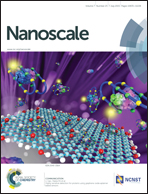Metal assisted anodic etching of silicon†
Abstract
Metal assisted anodic etching (MAAE) of Si in HF, without H2O2, is demonstrated. Si wafers were coated with Au films, and the Au films were patterned with an array of holes. A Pt mesh was used as the cathode while the anodic contact was made through either the patterned Au film or the back side of the Si wafer. Experiments were carried out on P-type, N-type, P+-type and N+-type Si wafers and a wide range of nanostructure morphologies were observed, including solid Si nanowires, porous Si nanowires, a porous Si layer without Si nanowires, and porous Si nanowires on a thick porous Si layer. Formation of wires was the result of selective etching at the Au–Si interface. It was found that when the anodic contact was made through P-type or P+-type Si, regular anodic etching due to electronic hole injection leads to formation of porous silicon simultaneously with metal assisted anodic etching. When the anodic contact was made through N-type or N+-type Si, generation of electronic holes through processes such as impact ionization and tunnelling-assisted surface generation were required for etching. In addition, it was found that metal assisted anodic etching of Si with the anodic contact made through the patterned Au film essentially reproduces the phenomenology of metal assisted chemical etching (MACE), in which holes are generated through metal assisted reduction of H2O2 rather than current flow. These results clarify the linked roles of electrical and chemical processes that occur during electrochemical etching of Si.


 Please wait while we load your content...
Please wait while we load your content...